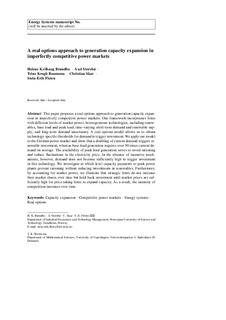| dc.contributor.author | Brøndbo, Helene Kvilhaug | |
| dc.contributor.author | Storebø, Axel | |
| dc.contributor.author | Fleten, Stein-Erik | |
| dc.contributor.author | Boomsma, Trine Krogh | |
| dc.date.accessioned | 2019-04-05T13:39:50Z | |
| dc.date.available | 2019-04-05T13:39:50Z | |
| dc.date.created | 2019-04-04T14:45:32Z | |
| dc.date.issued | 2019 | |
| dc.identifier.issn | 1868-3967 | |
| dc.identifier.uri | http://hdl.handle.net/11250/2593571 | |
| dc.description.abstract | This paper proposes a real options approach to generation capacity expansion in imperfectly competitive power markets. Our framework incorporates firms with different levels of market power; heterogeneous technologies, including renewables, base load and peak load; time-varying short-term demand and renewable supply; and long-term demand uncertainty. A real options model allows us to obtain technology-specific thresholds for demand to trigger investment. We apply our model to the German power market and show that a doubling of current demand triggers renewable investment, whereas base load generation requires over 50 times current demand on average. The availability of peak load generation serves to avoid rationing and reduce fluctuations in the electricity price. In the absence of incentive mechanisms, however, demand does not become sufficiently high to trigger investment in this technology. We investigate at which level capacity payments to peak power plants prevent rationing without reducing investments in renewables. Furthermore, by accounting for market power, we illustrate that strategic firms do not increase their market shares over time but hold back investment until market prices are sufficiently high for price-taking firms to expand capacity. As a result, the intensity of competition increases over time. | nb_NO |
| dc.language.iso | eng | nb_NO |
| dc.publisher | Springer Verlag | nb_NO |
| dc.title | A real options approach to generation capacity expansion in imperfectly competitive power markets | nb_NO |
| dc.type | Journal article | nb_NO |
| dc.type | Peer reviewed | nb_NO |
| dc.description.version | acceptedVersion | nb_NO |
| dc.source.journal | Energy Systems, Springer Verlag | nb_NO |
| dc.identifier.doi | https://doi.org/10.1007/s12667-019-00325-3 | |
| dc.identifier.cristin | 1690286 | |
| dc.relation.project | Norges forskningsråd: 209697 | nb_NO |
| dc.description.localcode | This is a post-peer-review, pre-copyedit version of an article published in [Energy Systems] Locked until 8.2.2020 due to copyright restrictions. The final authenticated version is available online at: https://doi.org/10.1007/s12667-019-00325-3 | nb_NO |
| cristin.unitcode | 194,60,25,0 | |
| cristin.unitname | Institutt for industriell økonomi og teknologiledelse | |
| cristin.ispublished | false | |
| cristin.fulltext | postprint | |
| cristin.qualitycode | 1 | |
